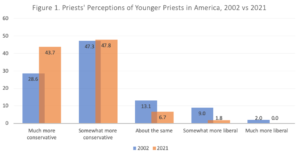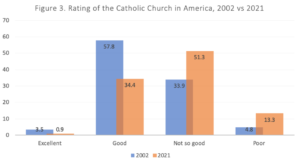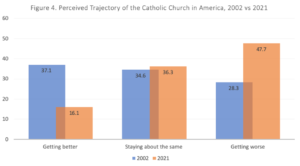A fascinating look at a study of changing attitudes in the active Priesthood. They seem to be more conservative and more realistic as to the state of the Church in the US.
From The Public Discourse
By Brad Vermurlen
Most Catholic priests in the United States perceive a conservative shift among younger priests. But progressive and conservative priests agree that the Catholic Church is not doing well, even if their reasons for saying so might be different.The Catholic priesthood in the United States tends to be more conservative today than in decades past. But it’s also more pessimistic about the current state and trajectory of the Catholic Church in America. That is the overarching story from a recent email survey of priests administered by the Austin Institute and analyzed in a new working paper Stephen Cranney and I co-authored with Mark Regnerus, who discussed findings on sexuality here yesterday. The full paper is now available to the public on the Social Science Research Network, a popular online repository of research papers.
In the decades since the Second Vatican Council there have been at least ten surveys of Catholic priests in the United States. But among prior surveys, the Los Angeles Times conducted a rare poll that asked about moral and sexual issues largely untouched in other priest surveys. Data from that 2002 survey served as the basis for a number of publications, both journalistic and academic.
The new Survey of American Catholic Priests was largely modeled after the 2002 survey. Replicating its questions verbatim allows researchers to assess changes over the intervening years. The survey was first fielded in late 2020 to an email list of priests derived from the Official Catholic Directory, and it was disseminated again in early 2021 to a different email list from a Catholic non-profit organization. Priests from the two email lists reveal findings that are reassuringly similar. The two sampling frames essentially provide a statistical validity check on each other. We therefore combined responding priests from the two email lists into a single dataset, producing a final sample size of 1,036 Catholic priests, including both diocesan and religious.
The survey included more than fifty questions. While the opportunities for further data analysis are abundant, in our introductory paper we limited ourselves to just eight areas: comparisons of the average (mean) answers on most questions in the survey (comparing the 2002 survey with the new one), priestly morale, views on moral issues, relationships to and evaluations of bishops, salvation exclusivism, perceptions of the conservatism or liberalism of younger priests, approval of Pope Francis, and the state of the Catholic Church in America.
Catholic Priests Are Becoming Increasingly Conservative
Most Catholic priests in the United States perceive a conservative shift among younger priests. Indeed, it is more common now than it was in 2002 to think that younger priests are more theologically conservative or orthodox than their older counterparts. Figure 1 depicts this point. In both 2002 and 2021, about 47 percent of priests said younger priests in America were “somewhat more conservative” than their older counterparts. However, the biggest change occurred as it pertains to seeing younger priests as “much more conservative.” The percentage of respondents who see younger priests as “much more conservative” increased from 29 percent in 2002 to 44 percent in the new survey. This shift in perception thinned out the opposite side of the response options; not a single priest in the 2021 survey agreed that younger priests today are “much more liberal” than their older counterparts.

Average responses, however, do not tell the whole story. We also broke down responses to several survey questions by respondents’ ordination year—or in this case, decade. On multiple questions, a common pattern clearly emerged. One finds a relatively conservative cohort of priests ordained prior to 1960 followed by more permissive or liberal men ordained to the priesthood in the 1960s and 70s. After the permissive cohorts, there is a steady move toward more conservative views with each successive cohort. Catholic priests ordained since the year 2000 tend to be the most conservative.
For example, Figure 2 displays the percentage of Catholic priests saying abortion is always a sin, broken down by ordination cohorts. Results from the 2002 L.A. Times survey are shown in blue, while results from the 2021 survey are in orange. The pattern is evident and is illustrative of the overall pattern we saw over and over on multiple questions (even while there are variations in the exact numbers for specific issues). The reader is cautioned, however, against perceiving any turn toward conservatism as a turn away from “grace.” Rather, it is a turn toward the Catholic Church’s consistent understanding of abortion as serious wrongdoing. Catholic priests seem no less interested in mediating forgiveness today; indeed, conservative priests spend more time in the confessional (results not shown).

Perhaps the most striking change from 2002 to the present concerns priests’ own perceptions of the current state of the Catholic Church in America. Both surveys asked priests: “Overall, would you rate things in the Catholic Church in America today as . . .” with response options of “excellent,” “good,” “not so good,” and “poor.” The basic findings are displayed in Figure 3. In 2002, 58 percent of priests said the state of things in the Church was “good,” but by 2021 over half (51 percent) now held that the state of the Church is “not so good.” Over that same period, the percent of priests rating the Catholic Church as “poor” leaped from 5 percent to 13 percent. Although the surveys don’t get into details about what priests think makes for a good, not so good, or poor state of the Church, there is no doubt a pronounced turn toward pessimism.

Findings about ratings of the Catholic Church in America are mirrored in a question about the current trajectory of the Church—that is, whether things generally are “getting better,” “staying about the same,” or “getting worse.” As shown in Figure 4, since 2002 there has been a significant shift in priests’ perceptions of the current trajectory of the Catholic Church. In 2002, 37 percent of priests said things were “getting better,” but by 2021 that figure had declined to 16 percent. On the other hand, in 2002, 28 percent of priests said things in the Catholic Church were “getting worse,” but by 2021 that figure had risen to nearly half of priests—48 percent.

When we dealt with survey questions about salvation or a host of moral issues, for example, and broke them down by priests’ ordination cohorts, there was a steady move toward more conservative answers among Catholic priests ordained more recently. This is suggestive of a cohort effect, meaning that overall changes in the composition of the Catholic priesthood on such issues are driven largely by more conservative priests being ordained while more progressive priests exit (through retirement or death).
That was not the case with the turn toward pessimism about the state and trajectory of the Catholic Church in America. When we break those two survey questions down by ordination cohorts, there is no consistent pattern of responses across cohorts. Instead, the most important pattern is between the 2002 and 2021 surveys. Optimistic answers more or less shrink in percentage regardless of the decade priests were ordained. This suggests that the turn toward pessimism since 2002 is a period effect, not driven by cohort patterns, meaning there is something distinct about the present time compared to nearly 20 years ago that makes priests (of whatever cohort) less optimistic.
We can’t say for sure why Catholic priests are more pessimistic now than in 2002. The survey doesn’t directly tackle the reasons. It could be that priests feel a heightened sense that American society has become a challenging, “post-Christian” cultural and spiritual climate. It might be that priests are in contact with laity who increasingly seem not to follow the Catholic Church’s teachings; the 2021 survey reveals an obvious drop in the percentage of priests who say most of the laity with whom they interact are following the Church’s teachings on moral issues such as sexuality, marriage, and reproduction (from 30 percent in 2002 to 22 percent now). Their pessimism, moreover, might reflect trends in the undesired direction such as a slight decline of Catholics as a share of the U.S. population since the early 2000s or declining parish membership among Catholics (even while these are mostly driven by generational cohorts). It could be continuing fallout from the sexual abuse scandals. Here it must remain an open question.
Those interested in the present-day beliefs, assessments, behaviors, and morale of Catholic priests in the U.S., and the ways such things have changed over the years, will want to view the full working paper, which includes seven tables and twelve charts on a variety of topics. The paper is available for download at the Social Science Research Network.
No comments:
Post a Comment
Comments are subject to deletion if they are not germane. I have no problem with a bit of colourful language, but blasphemy or depraved profanity will not be allowed. Attacks on the Catholic Faith will not be tolerated. Comments will be deleted that are republican (Yanks! Note the lower case 'r'!), attacks on the legitimacy of Pope Leo XIV as the Vicar of Christ, the legitimacy of the House of Windsor or of the claims of the Elder Line of the House of France, or attacks on the legitimacy of any of the currently ruling Houses of Europe.